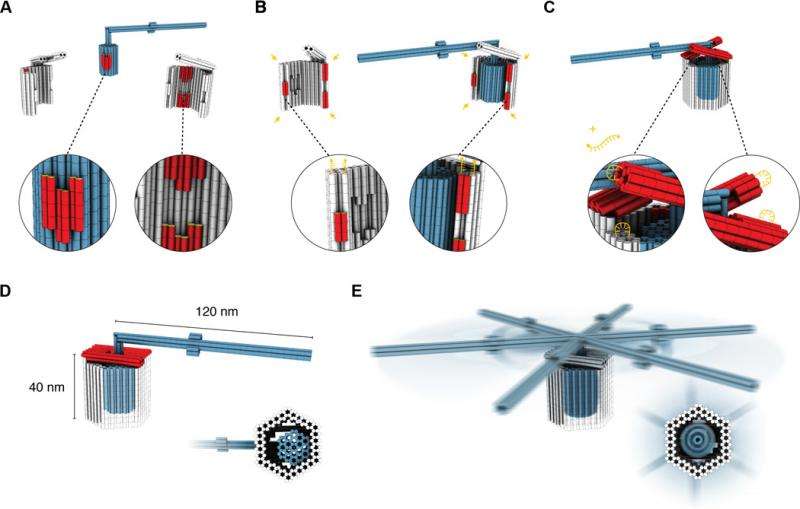February 22, 2016 report
Researchers build nanoscale rotary apparatus using tight-fitting 3D DNA components (w/ Video)

(Phys.org)—A trio of researchers with Technische Universität München has built a nanoscale apparatus that could one day serve as the basis for an extremely tiny motorized device. In their paper published in the journal Science Advances, the team describes how they built their device, how it works, and where they plan to take the new technology.
Scientists dream of building ever smaller motorized devices that could putter around inside the human body delivering medicines to ailing parts, toxins to tumors or simply serving as health monitors, but alas, such devices have not yet come to fruition—but they may be getting closer. In this new effort, the team in Germany has built a device based on synthetic DNA parts—it mimics, somewhat, the activities of flagella, the tiny arm-like appendages bacteria use as paddles to move around. It is only 40 nanometers tall but includes three main parts, a crank that spins, an axle bearing and a container to hold the other two parts together.
It does not yet have a power source, thus it cannot be called a motorized device just yet, instead, it can move around due to thermal energy which creates colliding water molecules which in turn causes the crank to turn—the team cannot control the direction of the device yet either, but believe they may have a solution sometime in the near future. They plan to test ideas using laser heat, ion flow or even chemical reactions to cause the crank to turn, and hopefully allow for controlling direction. If they succeed such a tiny motorized device would be useful in more than just medical applications—it could also possibly be used to drive chemical syntheses or to pump molecules across barriers.
The tiny device built by the team represents the first example of a biologically inspired nanomachine capable of demonstrating dynamic motor-like behavior. It also represents a step forward in nanoarchitecture—the device was built molecule-by-molecule and perhaps is the first step towards the development of true nanorobots. They note also, that after watching their device in action, it is not difficult to envision such devices motoring around inside of people, in a way very similar to how bacteria get around.
More information: P. Ketterer et al. Nanoscale rotary apparatus formed from tight-fitting 3D DNA components, Science Advances (2016). DOI: 10.1126/sciadv.1501209
Abstract
We report a nanoscale rotary mechanism that reproduces some of the dynamic properties of biological rotary motors in the absence of an energy source, such as random walks on a circle with dwells at docking sites. Our mechanism is built modularly from tight-fitting components that were self-assembled using multilayer DNA origami. The apparatus has greater structural complexity than previous mechanically interlocked objects and features a well-defined angular degree of freedom without restricting the range of rotation. We studied the dynamics of our mechanism using single-particle experiments analogous to those performed previously with actin-labeled adenosine triphosphate synthases. In our mechanism, rotor mobility, the number of docking sites, and the dwell times at these sites may be controlled through rational design. Our prototype thus realizes a working platform toward creating synthetic nanoscale rotary motors. Our methods will support creating other complex nanoscale mechanisms based on tightly fitting, sterically constrained, but mobile, DNA components.
Journal information: Science Advances
© 2016 Phys.org





















